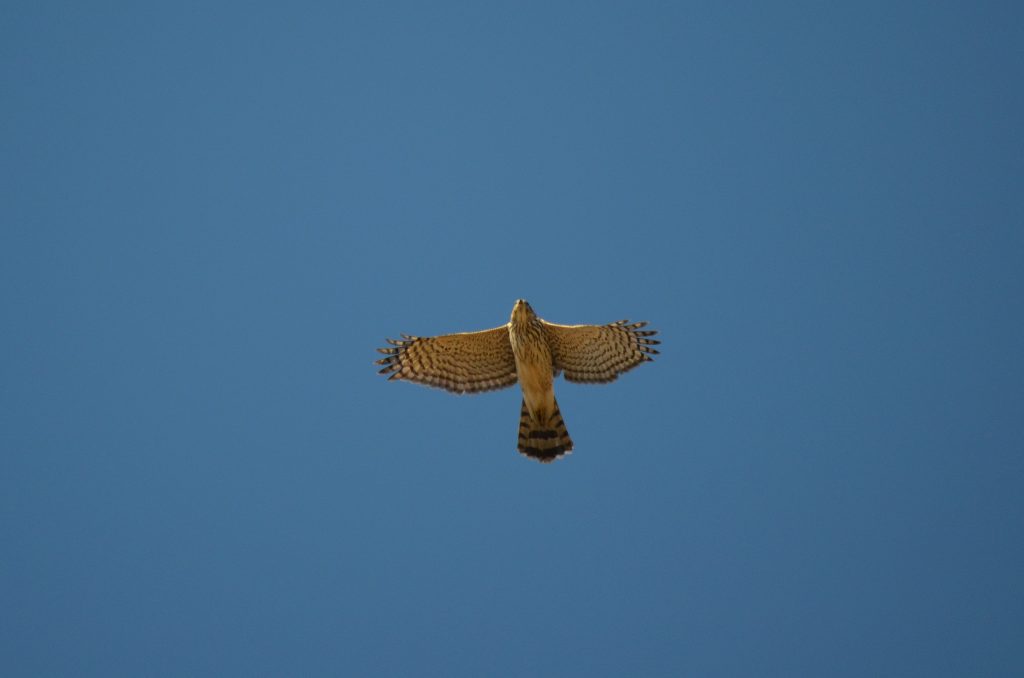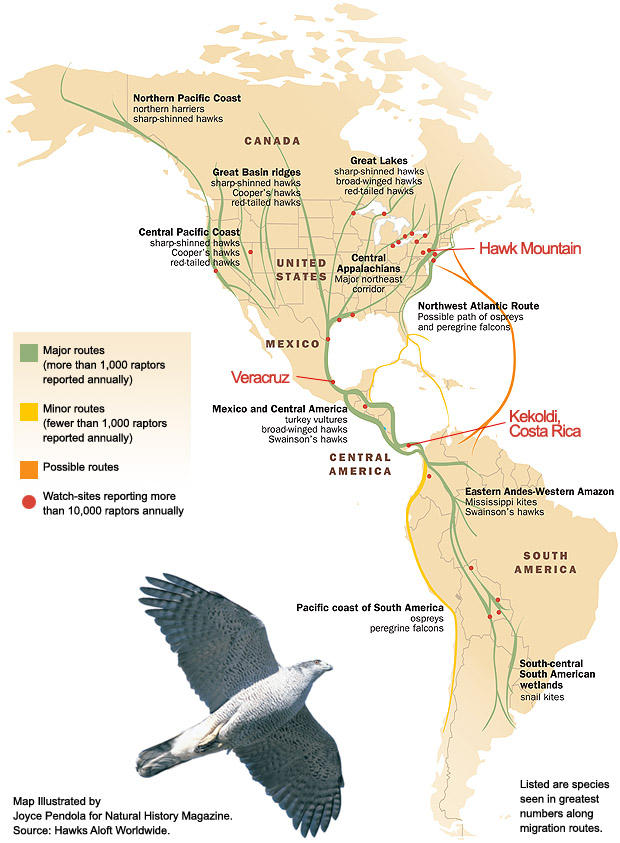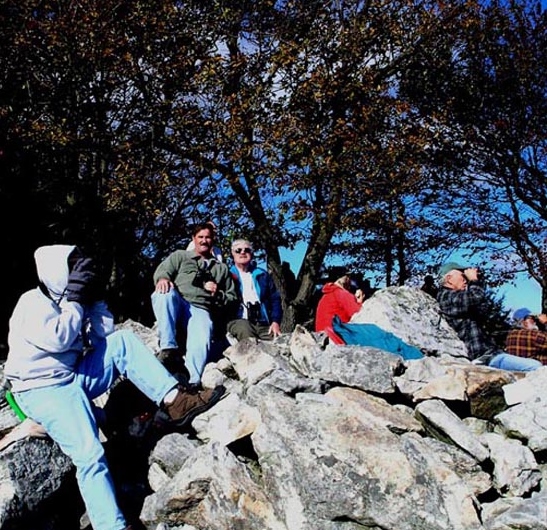I could start to feel the back of my neck getting sore, almost like I was experiencing a small cramp. It happens every year from about mid-September through the end of October, almost every day. I’ve been experiencing this temporary discomfort since I was 10 years old, and hopefully, will continue to experience it until I fade away! As weird as it sounds, I look forward to the neck ache every autumn! Why? Because it signals the start of one of the greatest shows on earth-the annual fall raptor migration! The constant tilting of my head looking toward the sky in search of these beautiful birds passing overhead is what causes the soreness, many times I’m also holding binoculars up to my eyes as well. But every hawk that I get a chance to see makes it so worthwhile!


The “show” starts as early as late August, and may continue until early December, but September and October are the prime months. Here in the Eastern U.S. during this time period thousands of hawks, eagles, falcons, kites and vultures make their way south along ridges of the Appalachian Mountains or along the Atlantic coast. Raptors also migrate through the Central and Western U.S. as well. The most popular time is probably mid-to late September, when thousands of Broad-winged Hawks will migrate south, many times in flocks of hundreds of birds, called kettles. The premier spot for hawk watching in North America is Veracruz, Mexico. Each fall, 4-6 million raptors migrate through Veracruz on their way to winter ranges in Central and South America. Because of the region’s geography, raptors from eastern, central, and western North America converge, providing visitors with a display unequaled anywhere on the planet.

Hawk watching, as it’s now known, has become quite popular in the past couple decades, with thousands of people visiting designated “Hawk Watches” throughout the United States, Canada and Mexico. It doesn’t take much, but a decent pair of binoculars helps. The added bonuses are that you’re usually watching them from very scenic sites during a great time of year, meet some great people, and can see lots of other migrants passing by as well. It’s not unusual to spot a variety of songbirds, waterfowl, monarch butterflies and dragonflies (yes, these migrate as well).

On several occasions I’ve also seen skydivers, several blimps and military fighter jets (including a Stealth). Since most hawk watches are covered by volunteers, it’s also become a very important aspect of citizen science that significantly contributes to critical raptor conservation. The Hawk Migration Association of North America collects hawk count data from almost 200 affiliated raptor monitoring sites throughout the United States, Canada, and Mexico. The organization is a driving force behind the Raptor Population Index (RPI), to promote scientific analysis of hawk count data. It also provides Hawk Count (www.hawkcount.org), a near-real-time international database of hawk counts across the continent. One of these is Hawk Mountain, in SE Pennsylvania, probably the most famous Hawk Watch in America. Its name reflects both its inauspicious past and its very bright future.

Photo courtesy of Gunnar Pettersson Photography
Located north of the small village of Kempton, Hawk Mountain was once the site of the slaughter of countless hawks shot down by gunners during the birds’ annual migration along the Appalachian Flyway. Today, however, the ridge that straddles the Berks-Schuylkill County line stands as a shining example of conservation success – a 2,500-acre wildlife refuge known around the world for its groundbreaking role in protecting raptors and their habitat.

The world’s first refuge for birds of prey, Hawk Mountain Sanctuary was founded in 1934 by New York conservationist Rosalie Edge after she saw photographs taken by amateur ornithologist Richard Pough. After visiting the mountain, Edge leased approximately 1,400 acres, naming Maurice Broun as Hawk Mountain’s first warden and ending the shooting of raptors on the ridge. Officially incorporated as Hawk Mountain Sanctuary in 1938, today the refuge is widely respected as a leader in raptor conservation and research work. It’s also an excellent destination for experiencing wildlife and the outdoors, offering visitors of all ages the opportunity to catch glimpses of more than 20 different raptors during their annual fall migrations.




Growing up in Pennsylvania, a trip to Hawk Mountain became an annual “migration” for me too. It started with my dad and I in the early 1970’s and 80’s. Then, two decades later, I was excited to introduce Hawk Mountain to my wife Theresa and sister, Cathy, and we tried to continue our tradition of visiting “The Mountain” at least once, every fall. However, back in the day, it was just me, Pa, our gear and food! Like a kid on Christmas Eve, I would eagerly pack our daypack the night before with binoculars, field guides, and lunches and snacks. Our food usually consisted of turkey sandwiches, chips, slices of ring baloney, a few apples and a half gallon of chocolate milk. We would leave before daylight and drive the 2 hours south to Hawk Mountain, from our NE Pennsylvania home. We always left early enough to navigate our way to a Mister Donut shop (precursor of Dunkin Donuts) for an egg sandwich and a jelly-filled doughnut! Pa taught me early on that a good birding trip was only as good as the food you ate along the way! Pa was right, and my wife and sister understand that, even today, “good munchies” are still required for any birding trip we plan together!

Upon our arrival at Hawk Mountain the ritual was always the same-quick bathroom break, pay our entrance fee and head straight to the North Lookout-a good, challenging 1.25 mile hike that ends at a large outcrop of rugged boulders. These massive rocks is your seating for the day-no chairs, benches or picnic tables here. Only rocks to sit on, with sensational 180-degree views of the Kittatinny Ridge straight in front of you, and the valleys below! Here you sit, as Pa, Theresa, Cathy and I have for nearly 40 years. As did thousands of people before us, and thousands of people since. You watch, you look and you listen, as “official counters” shout out migrating birds over distant landmarks, with odd names such as The Pinnacle, Donut, Hunter’s Field and Owl’s Head. It may not be an activity for everyone, but for those who enjoy the outdoors and nature, Hawk Mountain is a magical place. A place to sit, observe, reflect and marvel at these beautiful migrating birds.

Although we now live in Virginia, we’re still blessed with great hawk watching, as we live adjacent to the Blue Ridge Mountains, and have easy access to another fantastic Hawk Watch only 15 minutes from our home, called Rockfish Gap. This site also tabulates big numbers of migrating Broad-winged Hawks (the 2020 count so far is 29,279) each year, and as many as 14 other species as well.

As the official fall season sneaks in today (September 22nd), the hawks are once again on the move, soaring and winging their way south, thousands of miles to their wintering grounds. They come from the far reaches of Canada and northern U.S., some by themselves, others in large flocks. I know this because, once again, the back of my neck is sore from gazing toward the sky….I wouldn’t want it any other way! Cheers!